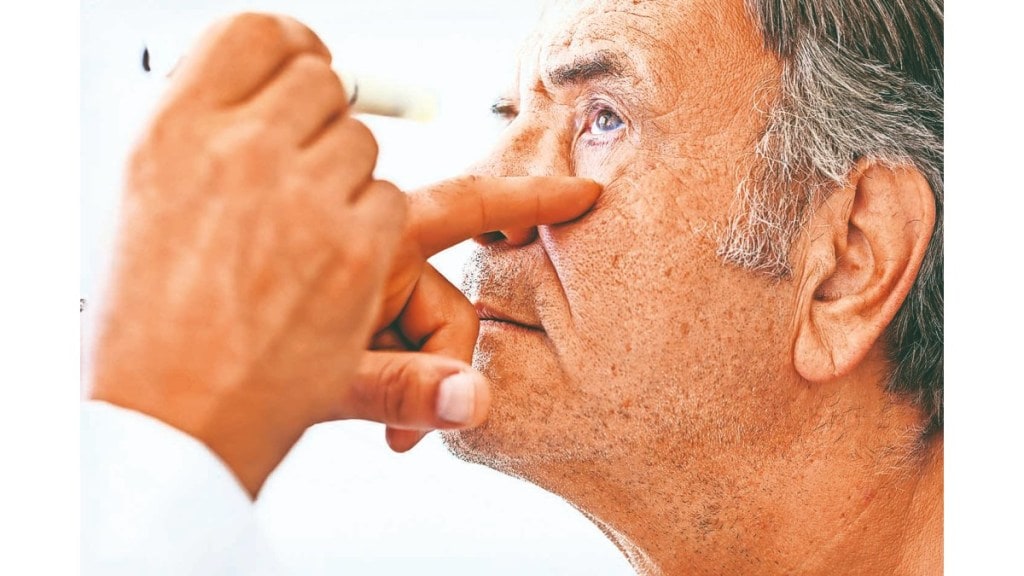Poor eyesight is a common problem, especially as one becomes older. Is there a way to check macular degeneration in the eyes, and how? Dr Uma Malliah, senior consultant, ophthalmology, Indraprastha Apollo Hospitals, says: “Age-related macular degeneration (AMD) is a progressive eye condition affecting the macula, the central part of the retina responsible for sharp vision. It can be checked through a comprehensive eye examination conducted by an ophthalmologist or optometrist. Key diagnostic methods include visual acuity tests, dilated eye exams, and optical coherence tomography (OCT), which provides detailed images of the retina.
Additionally, an Amsler grid test helps detect early signs of distortion in central vision, a hallmark of AMD. Fluorescein angiography may be used to identify abnormal blood vessels in wet AMD cases. While early stages may not present noticeable symptoms, regular eye check-ups are essential, especially for those over 50 or with a family history of the condition. Although there is no cure, early detection can slow progression through lifestyle changes such as a diet rich in antioxidants, omega-3 fatty acids, and lutein. In advanced cases, treatments like anti-VEGF injections and/or laser therapy, may help manage symptoms. Protecting the eyes from UV rays and maintaining overall health can also reduce the risk of AMD development.”
Can cataract be checked or even avoided altogether?
Cataract, a clouding of the eye’s natural lens, can be detected through a comprehensive eye examination. Symptoms include blurry vision, difficulty seeing at night, glare sensitivity, and faded colour perception. An ophthalmologist can diagnose cataracts using visual acuity tests, slit-lamp examinations, and retinal assessments. While cataracts primarily develop due to ageing, other risk factors include prolonged UV exposure, diabetes, smoking, prolonged steroid use, and genetic predisposition. Although cataracts cannot always be completely avoided, adopting preventive measures can significantly reduce risk. Wearing UV-protective sunglasses, maintaining a diet rich in antioxidants like vitamins C and E, managing underlying health conditions and lifestyle changes like quitting smoking can delay cataract formation. Regular eye check-ups allow early detection, and if cataracts progress to the point of interfering with daily life, surgery is a relatively safe and effective solution. Cataract surgery involves replacing the cloudy lens with a clear artificial lens, restoring vision with high success rates. Early intervention and proactive eye care play a crucial role in maintaining clear vision and avoiding cataract-related complications.
Does diet and lifestyle affect eye health and eyesight too?
Yes, diet and lifestyle play a significant role in maintaining eye health and preventing vision deterioration. Nutrient-rich foods support retinal function and reduce the risk of age-related eye conditions such as macular degeneration and cataracts. Essential nutrients include vitamin A (found in carrots and sweet potatoes) for night vision, vitamin C (in citrus fruits) and vitamin E (in nuts and seeds) for antioxidant protection, and omega-3 fatty acids (from fish and flaxseeds) for maintaining a healthy retina. Lutein and zeaxanthin, found in leafy greens, help filter harmful blue light and protect against macular damage. Lifestyle habits also impact eye health. Prolonged screen time can cause digital eye strain, leading to dryness, headaches, and fatigue. The 20-20-20 rule — taking a 20-second break every 20 minutes to look at something 20 feet away — can reduce strain. Regular exercise improves circulation, reducing the risk of diabetic retinopathy and glaucoma. Avoiding smoking helps protect blood vessels in the eyes, preventing conditions like optic nerve damage. Staying hydrated and getting enough sleep also support overall eye function. By adopting a healthy lifestyle and routine eye
check-ups, individuals can maintain optimal vision and reduce the risk of eye-related diseases.
An increasing number of children have poor eyesight. Why?
The rising prevalence of poor eyesight among children is a growing concern, often attributed to excessive screen time, reduced outdoor activity, and genetic predisposition. Digital devices such as smartphones, tablets, and computers expose children to prolonged near-work and blue light, contributing to digital eye strain and myopia (nearsightedness). Studies suggest that limited outdoor exposure affects eye development, as natural light plays a crucial role in preventing myopia progression. Additionally, increased academic pressures result in excessive reading and close-up tasks, straining the eyes further. Poor dietary habits also contribute, as a lack of essential nutrients like vitamin A, omega-3 fatty acids, and antioxidants can weaken eye health. Uncorrected refractive errors and delayed eye check-ups can worsen vision problems over time. Parents can help by encouraging outdoor play, enforcing screen-time limits, and ensuring a balanced diet rich in eye-friendly nutrients. Regular eye exams are essential for early detection and correction of vision issues. If left unaddressed, childhood myopia can lead to more severe complications. Addressing these risk factors early can significantly improve children’s long-term eye health and visual development.
